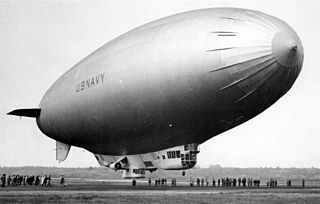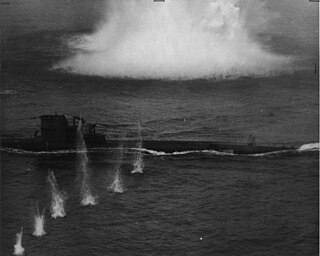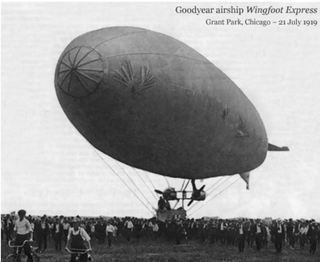
A blimp (/blɪmp/), or non-rigid airship, is an airship (dirigible) without an internal structural framework or a keel. Unlike semi-rigid and rigid airships, blimps rely on the pressure of the lifting gas inside the envelope and the strength of the envelope itself to maintain their shape. Blimps are known for their use in advertising, surveillance, and as observation platforms due to their maneuverability and steady flight capabilities.

An airship, dirigible balloon or dirigible is a type of aerostat or lighter-than-air aircraft that can navigate through the air flying under its own power. Aerostats use buoyancy from a lifting gas that is less dense than the surrounding air to achieve the lift needed to stay airborne.

The Goodyear Blimp is any one of a fleet of airships operated by the Goodyear Tire and Rubber Company, used mainly for advertising purposes and capturing aerial views of live sporting events for television. The term blimp itself is defined as a non-rigid airship—without any internal structure, the pressure of lifting gas within the airship envelope maintains the vessel's shape.

The K-class blimp was a class of blimps built by the Goodyear Aircraft Company of Akron, Ohio for the United States Navy. These blimps were powered by two Pratt & Whitney Wasp nine-cylinder radial air-cooled engines, each mounted on twin-strut outriggers, one per side of the control car that hung under the envelope. Before and during World War II, 134 K-class blimps were built and configured for patrol and anti-submarine warfare operations, and were extensively used in the Navy’s anti-submarine efforts in the Atlantic and Pacific Ocean areas.

The G-Class Blimps were a series of non-rigid airships (blimps) used by the United States Navy. In 1935, instead of developing a new design airship, the Navy purchased the Goodyear Blimp Defender for use as a trainer and utility airship assigning it the designator G-1. Defender was built by the Goodyear Aircraft Company of Akron, Ohio and was the largest blimp in the company’s fleet of airships that were used for advertising and as passenger airships. Goodyear built additional G-class airships for the Navy during World War II to support training needs.

The L-class blimps were training airships operated by the United States Navy during World War II. In the mid-1930s, the Goodyear Aircraft Company built a family of small non-rigid airships that the company used for advertising the Goodyear name. In 1937 the United States Navy awarded a contract for two different airships, K-class blimp designated K-2 and a smaller blimp based upon Goodyear's smaller commercial model airship used for advertising and passenger carrying. The smaller blimp was designated by the Navy as L-1. It was delivered in April 1938 and operated from the Navy's lighter-than-air facility at Lakehurst, New Jersey. In the meantime, the Navy ordered two more L-Class blimps, the L-2 and L-3, on September 25, 1940. These were delivered in 1941. L-2 was lost in a nighttime mid-air collision with the G-1 on June 8, 1942.

The Goodyear Aircraft Company of Akron, Ohio built the M-class blimp for the US Navy as the follow-on to the K-class anti-submarine warfare blimp used during World War II. It was a significantly larger airship, 50% larger than its predecessor. Four airships, designated M-1 through M-4, were delivered in early 1944. Operations of K-ships in tropical regions had shown a need for a blimp with greater volume to offset the loss of lift due to high ambient temperatures.

The N-Class, or as popularly known, the "Nan ship", was a line of non-rigid airships built by the Goodyear Aircraft Company of Akron, Ohio for the US Navy. This line of airships was developed through many versions and assigned various designators as the airship designation system changed in the post World War II era. These versions included airships configured for both anti-submarine warfare and airborne early warning (AEW) missions.

German submarine U-134 was a Type VIIC U-boat of Nazi Germany's Kriegsmarine during World War II. She was laid down on 6 September 1940 by Bremer Vulkan in Bremen-Vegesack as yard number 13 and commissioned on 26 July 1941. In seven patrols, U-134 sank three ships for a total of 12,147 gross register tons (GRT).

Beginning in 1908 and ending in 1937, the U.S. Army established a program to operate airships. With the exceptions of the Italian-built Roma and the Goodyear RS-1, which were both semi-rigid, all Army airships were non-rigid blimps. These airships were used primarily for search and patrol operations in support of coastal fortifications and border patrol. During the 1920s, the Army operated many more blimps than the U.S. Navy. Blimps were selected by the Army because they were not seen as "threats" on the battlefield by opposing forces, unlike airplanes, due to their passive role in combat.

The B class blimps were patrol airships operated by the United States Navy during and shortly after World War I. The Navy had learned a great deal from the DN-1 fiasco. The result was the very successful B-type airships. Dr. Jerome Hunsaker was asked to develop a theory of airship design, Lt. John H. Towers had returned from Europe having inspected British designs, and using reports from attachés on British airship operations, the Navy was prepared to seek bids for blimps from American manufacturers. On 4 February 1917 the Secretary of the Navy directed that 16 nonrigid airships of Class B be procured. A February 12, 1917 meeting with the Chief of the Bureau of Construction and Repair, and representatives of Goodyear, Goodrich, Connecticut Aircraft Company, Curtiss Aeroplane and Motor Corporation, and U.S. Rubber Company, it was agreed that the order for 16 dirigibles was beyond the capability of any one company. The conference resulted in a committee to coordinate on sharing raw materials, information and experience. Ultimately Goodyear manufactured 9 envelopes, Goodrich made 5 and Curtiss assembled the gondolas for all of those 14 ships. Connecticut Aircraft contracted with U.S. Rubber for its two envelopes and with Pigeon Fraser for its gondolas. The Curtiss-built gondolas used by Goodyear and Goodrich used modified Curtiss JN-4 fuselages powered by Curtiss OXX engines. The Connecticut Aircraft blimps were powered by Hall-Scott engines. One ship, B-20 was equipped with a special control car. All B-Class airships were delivered to the Navy between August 1917 (B-1) and September 1918 (B-20).

The D class blimp was a patrol airship used by the US Navy in the early 1920s. The D-type blimps were slightly larger than the C-type and had many detail improvements. The Navy continued the practice of dividing the envelope production between Goodyear and Goodrich. The control cars were manufactured by the Naval Aircraft Factory. The major improvements over the C-type blimps were a better control car design and easier, more reliable controls and instrumentation. The engines were moved to the rear to reduce noise and allow easier communications between crew members. The fuel tanks were suspended from the sides of the envelope. The envelope was identical to the C-type, except an additional six-foot panel was inserted for a total length of 198 feet (60 m) and a volume of 190,000 cubic feet (5,400 m3). The last of the D-Class, D-6, had a redesigned control car by Leroy Grumman who later founded the Grumman Aircraft Engineering Corporation.

The Wingfoot Air Express was an early Goodyear blimp that caught fire and crashed into the Illinois Trust and Savings Building in Chicago on July 21, 1919. The Type FD airship, owned by the Goodyear Tire and Rubber Company, was transporting passengers from Grant Park to the White City amusement park. One crew member, two passengers and ten bank employees were killed in what was the worst airship disaster in the United States up to that time.
The Goodyear Type AD was a small airship built in the United States in the mid-1920s. The first example, christened Pilgrim, was Goodyear's first civil airship, and their first airship to use helium as its lift gas. Originally intended for pleasure cruising, it soon found its true calling as a promotional vehicle as the first "Goodyear Blimp" in a line that has continued for over ninety years. The Type AD was a conventional blimp design with a gondola that could carry two passengers in addition to the flight crew. While usually described as a non-rigid type, the design in fact incorporated a triangular-section magnesium girder as a keel, fastened inside the envelope. The craft carried its own collapsible mooring mast which allowed it to "land" anywhere that 250 ft × 250 ft of clear ground was available.

The Goodyear GZ-20/20A was a class of non-rigid airship or blimp introduced in 1969 by The Goodyear Tire and Rubber Company in the United States as its signature promotional aircraft, the Goodyear Blimp. The design is based on the previous Goodyear GZ-19 class. The GZ-20 featured a larger envelope to carry the "Super-Skytacular" advertising night sign and more powerful engines. The GZ-20s were the mainstay of Goodyear's airship operations until 2017, when they were replaced with the new Zeppelin NT semi-rigid airship.

The Coastal Class were a class of non-rigid airship or "blimp" used by the Royal Naval Air Service (RNAS) during World War I. The C-class blimp operated by the United States Navy after the war was a completely unrelated design. In total 35 Coastals were built, all at RNAS Kingsnorth, Kent. Entering service in 1916, the Coastal class remained in widespread service until 1918, with a few members of the class still in service at the signing of the Armistice, while others were replaced by the improved C-Star class as they became unfit for service. The blimps were used for long anti-submarine patrols in the Western Approaches and English Channel, protecting convoys from German U-boats. The Coastal class was one of the first aircraft types specifically designed to detect and attack submarines.
The Loral GZ-22 was a class of non-rigid airship, or blimp first flown in 1989 and operated by Goodyear as its flagship promotional aircraft, with civil registration N4A and christened Spirit of Akron. This was the only airship of this class ever built. Goodyear originally designed the GZ-22 to demonstrate the possible renewed use of airships to the United States Navy, which had ended their airship operations in 1962. The GZ-22 was designed by Goodyear, but built by Loral after Goodyear sold its aerospace division to Loral in 1987. The GZ-22 had a steel-framed, composite-skinned gondola under a neoprene-impregnated polyester 2-ply envelope, inflated with helium. At its launch in 1987, the 205-foot 6-inch long Spirit of Akron was the longest airship in service at that time. The GZ-22 Type Certificate was issued on 31 August 1989.

C-5 was a C class blimp operated by the U.S. Navy in 1918 and 1919. It was one of ten C class hydrogen inflated non-rigid airships constructed by Goodyear and Goodrich primarily for naval patrol duty and training during World War I.
In the nation's quest to provide security along its lengthy coastlines, air reconnaissance was put forth by the futuristic Rear Admiral William A. Moffett. Through his efforts, two Naval Air Stations were commissioned in the early 1930s to port the Naval Airships (dirigibles) which he believed capable of meeting this challenge.
The United States Navy proposed to the U.S. Congress the development of a lighter-than-air station program for anti-submarine patrolling of the coast and harbors. This program proposed, in addition to the expansion at Naval Air Station and Lakehurst, the construction of new stations. The original contract was for steel hangars, 960 ft (290 m) long, 328 ft (100 m) wide and 190 ft (58 m) high, helium storage and service, barracks for 228 men, a power plant, landing mat, and a mobile mooring mast.
















